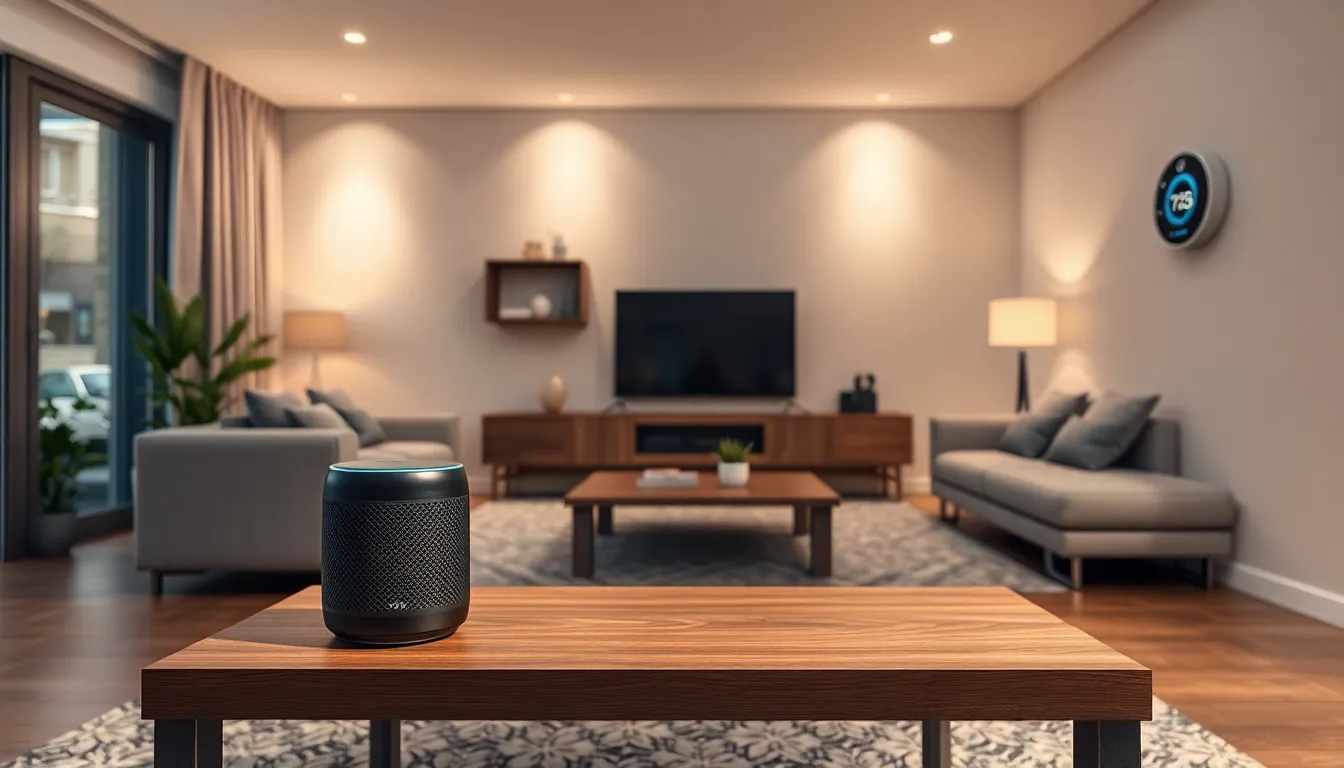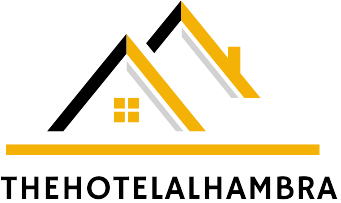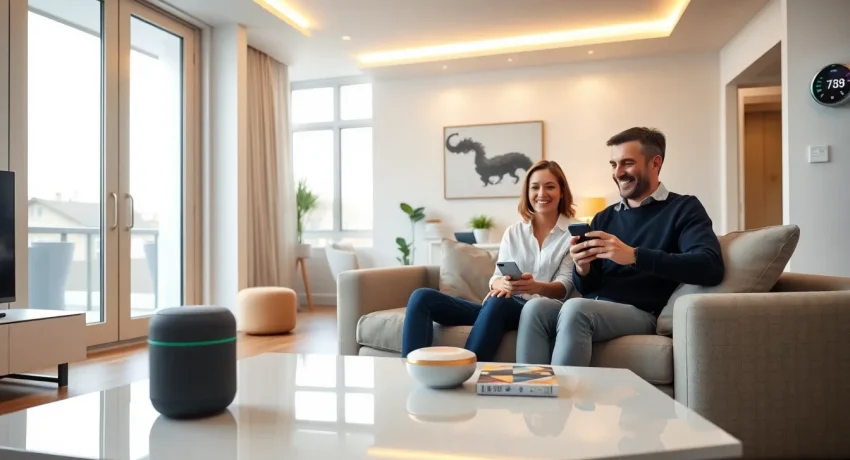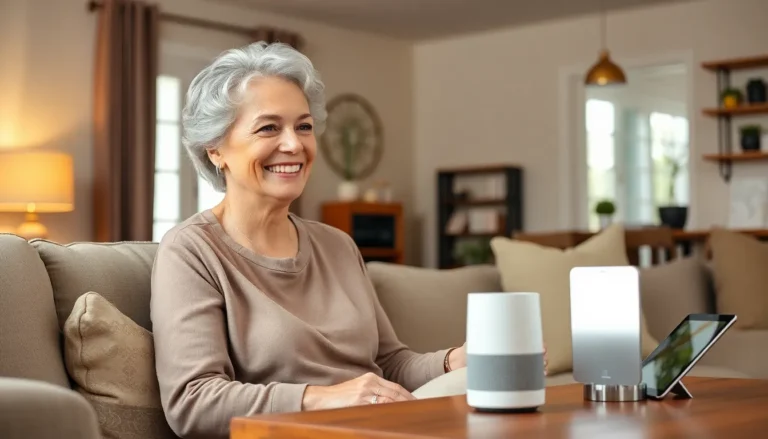Table of Contents
ToggleImagine walking into a home that anticipates your every need. Automated homes are revolutionizing the way people live, making everyday tasks simpler and more efficient. With smart devices seamlessly integrated into daily routines, homeowners can enjoy greater comfort and convenience while enhancing security and energy efficiency.
As technology advances, the allure of automation grows. From voice-activated assistants to smart thermostats, these innovations not only save time but also reduce energy costs. The shift towards an automated home isn’t just a trend; it’s a lifestyle change that empowers individuals to take control of their living environments. Embracing this technology opens up a world of possibilities, transforming houses into intelligent, responsive spaces that adapt to their inhabitants.
Overview Of Automated Homes
Automated homes integrate smart technology to enhance living environments. Smart devices such as voice-activated assistants, security cameras, smart locks, and automated lighting systems allow residents to control various aspects of their homes seamlessly. These technologies create a streamlined user experience, promoting efficiency in daily tasks.
Energy management is a crucial feature of automated homes. Smart thermostats can adjust heating and cooling based on occupancy patterns, significantly reducing energy consumption. Studies show that homes with automated systems can decrease energy use by up to 30%.
Security features in automated homes contribute to enhanced safety. Real-time monitoring through security cameras and motion sensors alerts homeowners of unusual activity. Smart locks provide remote access, allowing homeowners to control entry points through their smartphones.
Automation improves convenience, enabling homeowners to manage devices through voice commands or mobile apps. This technology fosters a more comfortable lifestyle by simplifying everyday tasks. As the market for automated home devices grows, innovative solutions will emerge, further integrating technology into daily routines.
Benefits Of Automated Homes

Automated homes offer numerous advantages that significantly enhance daily living. These benefits include increased convenience, improved energy efficiency, and heightened security.
Convenience And Comfort
Convenience and comfort define the automated home experience. Smart devices like voice-activated assistants streamline daily routines by enabling hands-free control of home systems. Automated lighting adjusts according to user preferences, while smart thermostats ensure optimal temperature settings without manual adjustments. Homeowners manage tasks remotely using mobile apps, allowing control of appliances and systems from any location. This seamless integration contributes to a more relaxed environment where comfort meets technology.
Energy Efficiency
Energy efficiency serves as a key benefit of automated homes. Smart thermostats analyze occupancy patterns and adjust heating and cooling settings, positioning homeowners to reduce energy consumption by up to 30%. Automated lighting systems utilize motion sensors, ensuring lights operate only when needed. Energy management systems provide real-time data, allowing homeowners to monitor consumption and implement strategies for reduction. Overall, these features not only lower utility bills but also contribute to an eco-friendly lifestyle.
Enhanced Security
Enhanced security represents a crucial aspect of automated homes. Smart locks allow remote entry management, ensuring homeowners can secure their properties even when away. Real-time monitoring through security cameras keeps individuals informed about activities around their homes. Integration with alarm systems provides alerts for suspicious behaviors, increasing overall safety. These automated security features work together to create a comprehensive safety net that provides peace of mind for homeowners.
Key Components Of Automated Homes
Automated homes integrate various components that contribute to their functionality. Key components include smart devices, appliances, and home automation systems.
Smart Devices And Appliances
Smart devices and appliances form the backbone of automated homes. They encompass a wide range of products designed to enhance convenience and efficiency, including:
- Voice-Activated Assistants: Devices like Amazon Echo and Google Home allow users to control other smart devices using voice commands.
- Smart Thermostats: These devices learn user preferences, adjusting heating and cooling automatically. They can potentially reduce energy bills by optimizing climate control.
- Smart Lighting: Automated lighting systems can be programmed to adjust based on time, occupancy, or user commands, offering flexibility and energy savings.
- Smart Security Cameras: These cameras provide real-time video feeds and alerts, enhancing home security through remote monitoring capabilities.
- Smart Locks: Keyless entry systems let homeowners manage access and monitor entry points from anywhere using a smartphone app.
Home Automation Systems
Home automation systems enable seamless integration and control over multiple devices within automated homes. Essential features include:
- Centralized Control Hub: A central hub, like Samsung SmartThings, connects various smart devices, allowing users to control them through a single interface.
- Zigbee and Z-Wave Protocols: These communication protocols facilitate device compatibility, ensuring that devices from different manufacturers work together smoothly.
- Mobile Applications: Smartphone apps provide homeowners the ability to manage their home systems remotely, adjusting settings or receiving alerts while away.
- Scheduled Automation: Users can set schedules for devices, such as turning on lights at sunset or adjusting thermostats during off-peak hours, optimizing both energy use and convenience.
Together, smart devices and home automation systems form a cohesive ecosystem that transforms traditional living spaces into intelligent environments tailored to individual preferences.
Challenges And Considerations
Automated homes offer numerous advantages, but they also present challenges and considerations that homeowners must evaluate carefully.
Cost And Investment
Cost represents a significant factor when implementing automation in homes. Initial investments range from a few hundred to several thousand dollars, depending on the complexity and number of devices involved. Smart devices, home automation systems, and installation fees contribute to this expense. Homeowners should consider long-term savings from energy efficiency against upfront costs. For instance, smart thermostats may result in energy savings of up to 30%, potentially offsetting their price over time. Additionally, ongoing maintenance and software updates can incur further costs, making it essential to budget accordingly.
Privacy And Security Concerns
Privacy and security concerns are critical when adopting automated home technology. Smart devices often collect personal data, raising potential risks if not adequately protected. Cybersecurity vulnerabilities can lead to unauthorized access to home networks, exposing sensitive information. Homeowners should prioritize devices with strong encryption and regularly update software for enhanced security. Implementing robust passwords and utilizing two-factor authentication can further safeguard smart systems from potential breaches. It’s crucial to assess device privacy policies and user permissions to manage data-sharing preferences effectively.
Future Trends In Automated Homes
Automated homes continue to evolve, driven by advancements in technology and consumer demands. Several trends are shaping the future of smart home integration.
- Artificial Intelligence Integration: AI algorithms analyze patterns in homeowner behavior, further customization of automated systems. This technology allows devices to anticipate needs, enhancing user experience.
- Increased Interconnectivity: The trend toward inter-device communication strengthens system cohesion. Protocols like Matter aim to promote compatibility across various manufacturers, ensuring seamless control of all connected devices.
- Energy Management Solutions: Next-generation smart thermostats and energy monitoring systems can optimize energy use with even greater precision. These technologies provide real-time consumption data and suggest strategies to reduce costs.
- Enhanced Security Protocols: Enhanced encryption and biometric authentication methods refine smart home security. Advancements in AI-driven surveillance provide better threat detection and response capabilities.
- Sustainability Focus: Eco-friendly smart devices will drive sustainable home practices. Homeowners increasingly seek technology that supports energy conservation, using renewable energy sources and reducing waste.
- Health Monitoring Devices: The integration of health-focused devices into automated homes promotes wellness. Wearables and smart health systems can gather health data, helping users manage chronic conditions from home.
- Voice and Gesture Control: Voice recognition technology is becoming more sophisticated, enabling hands-free interactions. Gesture control offers another layer of convenience, allowing users to manage devices without physical contact.
- Adaptable Home Environments: Flexible and adaptable automated systems will cater to evolving user needs. Future developments may focus on customizable environments that adjust according to personal preferences or lifestyle changes.
These trends indicate a strong shift towards smarter, more responsive homes that cater to individual preferences and enhance overall living experiences. Automated home technologies will continue to create comfortable, efficient, and secure environments for homeowners.
Automated homes represent a significant shift in how people interact with their living spaces. By integrating smart devices and advanced technology, homeowners can enjoy unparalleled convenience and security. The benefits extend beyond mere comfort; energy efficiency and enhanced safety are now achievable through intelligent systems.
As technology continues to evolve, the future of automated homes looks promising. Innovations in artificial intelligence and interconnectivity will likely redefine living experiences, making homes even more responsive to individual needs. Homeowners who embrace these advancements can expect a lifestyle that not only simplifies daily tasks but also promotes a sustainable and secure environment.




